Reginald Spittle's Blog: See my book blog, page 24
April 13, 2021
The Real Madness of Mental Illness
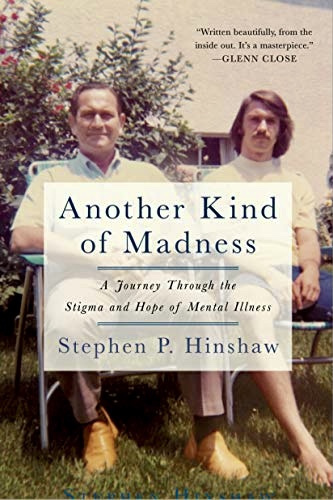
Harvard freshman Stephen Hinshaw was back home in Columbus, Ohio for spring break. His father, prominent Ohio State philosopher Virgil Hinshaw Jr., called him into his study for a talk. Within minutes, the son’s life changed forever.
For Stephen, the ensuing talks with his father answered questions he had kept buried for a lifetime. Why did Dad disappear all those times? Where did he go?
In Another Kind of Madness: A Journey Through the Stigma and Hope of Mental Illness Stephen Hinshaw brilliantly shares his family’s story.
Now an eminent psychology professor at UC Berkeley, the author relates his father’s story. He tells how his family’s silence left its marks that he sees in himself every day.
Where did his dad go all those times? To various institutions for what was diagnosed at the time as schizophrenia. The treatments were extreme and included electric shock therapy.
Why did his father have to go away? His highs and lows were so extreme that he was unable to function in his job, in his family. Later came the diagnosis of bipolar disorder, or manic depression.
Stephen Hinshaw describes how ending the silence and stigma attached to mental illness can heal and even prevent scars in patients and their families. The book will help some readers recognize scars in themselves.
Another Kind of Madness envisions a world in which stigma is no longer attached to any condition of human life.
April 2, 2021
You Can Make Anxiety Your Friend

If you are worried that you don’t know how to deal with anxiety, Sarah Rayner may be the just the person who can help.
Making Friends With Anxiety may seem like a terrible title if anxiety threatens your peace of mind, follows you everywhere, and ruins what should be the best of times. So, if making anxiety your enemy makes it worse, what should you do?
Rayner uses the gentle approach of a friend who understands. She describes how-to exercises and tips about life, including diet, breathing, and handling criticism. She breaks down medications, how to approach your doctor, the kinds of anxiety, and much more.
The author knows from experience. At one point, she admitted herself to a clinic to get help. Her struggle is real. Her words are genuine.
She helped me understand that my body sets off adrenaline and other stress hormones as a signal that something is wrong. It showed me it is harmful to come down hard on myself when I can’t necessarily stop the physical symptoms.
She makes it clear anxiety can be a difficult friend to live with. But Making Friends With Anxiety is full of support and hope.
As a companion book, have you read The Four Agreements by Don Miguel Ruiz? Click the title to see my brief discussion about one of the greatest books related to mental well-being.
My best wishes.
March 28, 2021
A Himalayan Journey Born as a Dream
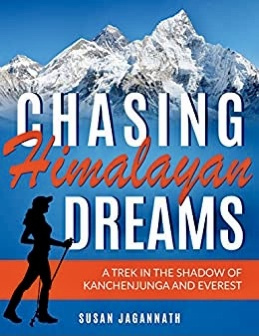
Living in her native India, Susan Jagannath fell in love at first sight. She was just 16. But she would have to wait until she was in her 60s to realize her dream, a closeup view of the object of her affection.
In Chasing Himalayan Dreams, Jagannath describes her journey on the Singalila Ridge Trek along the Nepal-India border to Sandakphu, where she gazes across 30 miles of blue sky to Kanchenjunga, the sacred mountain. On the 38-mile guided walk, she travels through villages, soaking up local culture.
The peak she first glimpsed at 16 is not just any mountain. Billed as the world’s tallest until 1852, Kanchenjunga elevation is 28,169 feet. It resides among four of the tallest peaks, including Mt. Everest. And Kanchenjunga has never been summited. By tradition and out of respect for its sacred designation, climbers stop short of its tallest point.
Her book is a quick, easy page-turner. I celebrated when the author, who lives in Australia, climbed to the viewpoint at Sandakphu, at an altitude of 12,100 feet. I had my fingers crossed that clouds would not stand between her and her mountain. If they had, I think Susan Jagannath would not have quit her dream to get a clear look at her first love.
March 23, 2021
UCSB: What Is a University?


A former roommate’s note sent me back to my UCSB La Cumbre yearbook, where I rediscovered my published essay next to a photograph of me at 20 years old.
Would these words resonate in 2021?
Ideally the University is an institution of higher learning, a place where students expand their horizons into the realms of discipline and intellectualism. To reach this peak, it requires listening attentively to lectures, cramming books into your mind and getting rid of emotion that might make you identifiable with ordinary people.
The University carries on the American capitalistic tradition of instilling the sense of competition in all its subjects in order that the country reach new highs in technological advancement. But what is all this worth in a world filled with hate, fear and hunger?
In my view, the University is an extremely valuable part of our world, but not in these ways. It is a place where we can learn to understand people, not only the type we identify with or like, but also people we might otherwise condemn.
We study different cultures, political systems and individuals and through this we gain an understanding of the world in its present state. This is the basis for revision–we cannot bring about effective change without understanding what we want to change.
But perhaps the most valuable part of life in the University is the constant contact with people and the opportunity for involvement in a variety of experiences. This is the University–a place where books and classes play a secondary role to people meeting and enjoying each other.
My generation, which came of age during the tumultuous late 1960s, vowed to change the world. How did we do?
February 27, 2021
Camino Sunrise: Thank You, Readers!
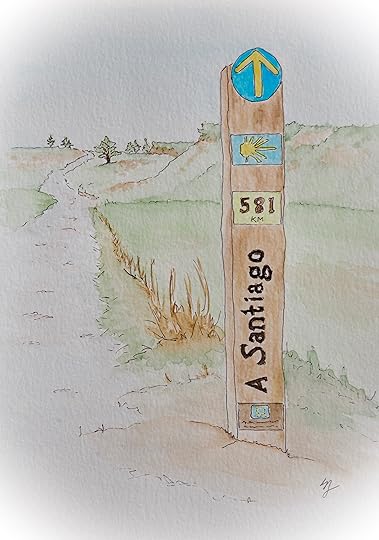
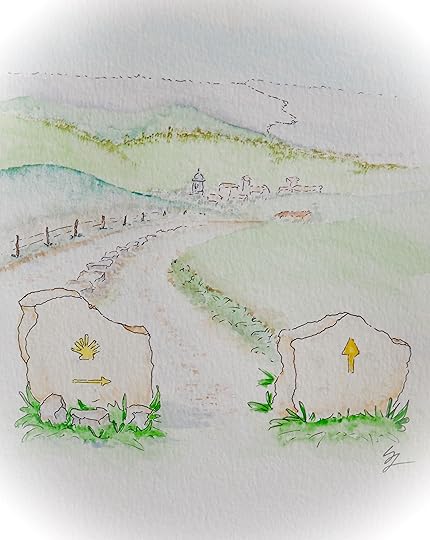
I am grateful for two reviews of Camino Sunrise: Walking With My Shadows that arrived this week via Amazon. Also, I am thankful for my wife Sue’s ink-and-watercolor art. There is rarely a shortage of signs on Spain’s Camino de Santiago. To everyone who has shared our journey: Thank you!
From the United Kingdom: “While reading this book I was transported to the Camino. The descriptions of the people, difficulties and triumphs are so vivid and told with humour and insight. I got totally engrossed in it and could imagine myself walking with the author and his wife. They would be such entertaining companions. Great read.”
From the USA: “I’ve lived vicariously for years reading others’ adventures hiking the Camino. This book was my favorite! Down to earth, funny, moving, heartfelt, loved it, felt like I was taking the journey along with the author. I would definitely read other books he writes.”
Our adventures on Scotland’s West Highland Way, the Alps’ Tour du Mont Blanc, Italy’s Way of St. Francis, and England’s South West Coast Path are getting closer to publication. Stay tuned!
February 24, 2021
Rocket Boys: A Great American Comeback
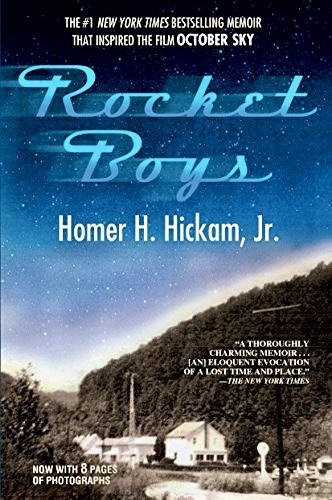
Sputnik’s launch in 1957 thrust the Soviet Union into first place in the space race, causing fear about where its domination would lead.
But for some Americans, like Homer “Sonny” Hickam, the launch was just what they needed to transform imagination, ingenuity and hard work into a great American success story. From 1957 through 1960, Sonny and his West Virginia high school classmates, as the Big Creek Missile Agency, fired off 35 rockets, some wildly successful, some wildly disastrous.
Nearly four decades later, Hickam published Rocket Boys, a memoir that has flown off the shelves since, leading to the acclaimed film October Sky.
The boys dreamed that they would go to the moon, that their rockets would reach space, that they would escape a life working in the coal mine in Coalwood, West Virginia. But, in their wildest dreams, they could not have foreseen where their experiments would take them, their families, their community, their nation. As badly as Homer and his fellow scientists wanted out of Coalwood, their hometown came through for them when everything they had worked for was on the line.
Rocket Boys is an inspiring story for those who value education, community, family, and the dreams of kids growing up in West Virginia–or anywhere.
February 21, 2021
Hike Oregon! But Don’t Forget Your Guide
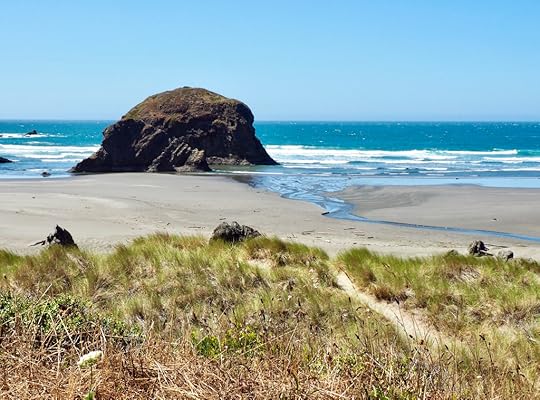
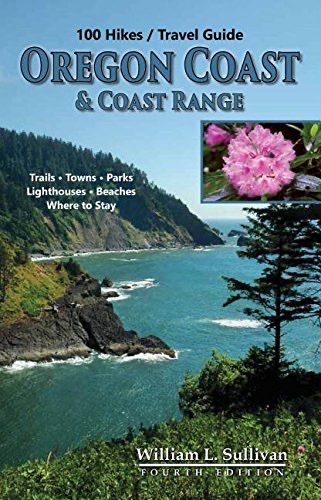
Lace up your walking shoes, pack a lunch and head to the Oregon coast for some of the best day hikes in America. And if you are a regular walker around the state, you will not be caught without your William L. Sullivan guidebook.
Sullivan, who once backpacked solo for 1,361 miles in his beloved state, has written 18 books about Oregon, which is similar in size to Great Britain and, like Britain, is known for valuing public pathways. His book about the Oregon coast is one of five regional offerings that feature 100-plus day hikes each. He also chose his 100 favorites for a book covering the entire state.
Hand-drawn maps, difficulty ratings and user-friendly narratives have guided Sue and me on countless walks around Oregon since we moved to Ashland in 2014.
One of our most memorable outings, described in the Oregon Coast and Coast Range guide, is actually more of a drive than a walk. After 12 miles of a twisting, rough gravel road that begins near the southern city of Brookings, Sullivan’s book guides walkers to a 1.6-mile trail, round trip. This one is all about the destination, a Japanese bombing site. On September 9, 1942, a small plane was assembled on the deck of a Japanese submarine off the coast of southern Oregon. After the wings were attached, a pair of incendiary bombs were loaded. A catapult launch sent the plane inland for its mission: Start a forest fire to undermine America’s war effort. Sullivan tells the story and leads hikers to the bombing site. It is a beautiful, forested walk to an observation deck where signs chronicle pilot Nobuo Fujita’s daring attack.
Besides many rewarding walks on the coast, Sullivan’s Northwest Oregon guide has led us on spectacular adventures near Bend, a mecca for outdoor enthusiasts. We are also partial to his guide about southern Oregon, our home.
When we depart on a trip to explore Oregon, we never leave home without Sullivan’s invaluable guidance.
February 14, 2021
Chasing Dreams in a VW Bus

In 1972, Jerry Steimel graduated college, jumped in a VW Beetle with his lifelong friend, and set out to live his dream, a cross-country trip to California. But his VW Bug had other ideas, quickly ending the trip with mechanical breakdown.
Steimel’s dream wasn’t deterred. Forty-five years later, he jumped in another Volkswagen, a 1973 air-cooled van, and set out from his home in Massachusetts for another try, this time solo. But Jerry Steimel hardly traveled alone.
In Chasing Zorba: A Journey of Self-Discovery in a VW Bus, he is guided by author Nikos Kazantzakis and his book, Report to Greco, whose life lessons begin each chapter. He names his van Zorba after Kazantzakis’ book Zorba the Greek. Steimel’s goal: California. And so much more.
Some call his plan lunacy. But Steimel is out to discover comfort in taking risks rather than living as if he is just waiting to die. He doesn’t hurry, neither in his writing nor his driving, and his literary and physical journeys are a meander. But, in the end, the book rushes up and grabs readers before leaving them with memories anchored in what it means to live life to its fullest.
Steimel goes to great lengths to find places, like the West Virginia site where four high school boys launched rockets and their lives to heights beyond their wildest dreams. It is the site of the film October Sky, which Steimel watched a dozen times. That figures, you see, because Jerry devoted 45 years to social work, lifting kids who needed an extra push.
Steimel weaves places and American history with the people he meets as he drives mostly back roads, having to stop more than now and then to take Zorba to mechanics for adjustments. The journey tests Steimel and Zorba in ways they could never have anticipated.
The author and his VW Bus still miss the turn of the key every morning. And I miss wondering what is around their next turn.
February 5, 2021
Four Treks, Four Adventures, Four Tests


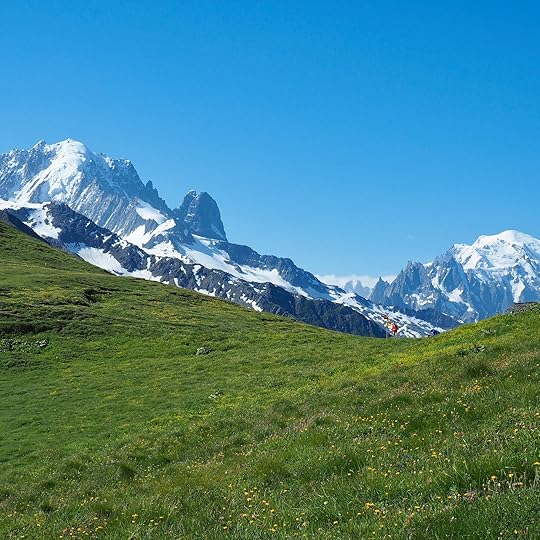

The Camino Frances inspired Sue and me to backpack four more European distance treks, each with a unique personality. A closed sign greeted us at an ancient aqueduct as we left Spoleto, Italy on the Way of St. Francis in 2018. Part of the official path, the aqueduct was closed after a 2016 earthquake, forcing us to turn around and walk a lengthy detour. How many stairs are there on England’s South West Coast Path? We climbed and descended many of the 30,000 steps in 2019. Glaciers on the Mont Blanc massif frame our favorite accommodation on the Tour du Mont Blanc, Rifugio Elisabetta, in 2016. An ingenious drying rack was a godsend at the Lander Bed and Breakfast in Drymen on the West Highland Way in 2014. Our adventures on the four treks are featured in my second book, coming soon.
February 2, 2021
Smokejumper Flips His PCT
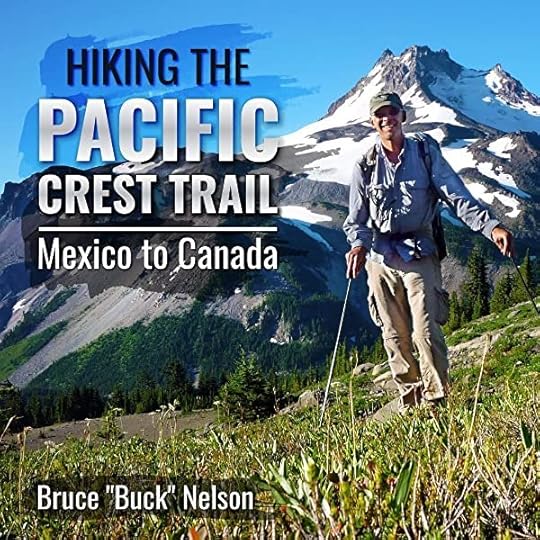
On the Camino de Santiago, the world’s most-traveled long-distance trek, pilgrims like to say, “Everyone walks their own Camino.”
In Hiking the Pacific Crest Trail: Mexico to Canada, Bruce Wilson describes how he inserted a “flip” in his 2,650-mile endurance test. He began at the Mexican border in April and arrived in the Southern Sierra Nevada early, with dangerously high snow levels ahead. He got rides to Ashland, Oregon, where he flipped his PCT and walked back to the southern Sierra, where he left off. He still faced snow and snowmelt-fed waterways, but his PCT was safer, more passable. To complete his flip, he got rides back to Ashland and resumed his trek.
Nelson’s book brings home the challenges of backpacking for months on difficult terrain that reaches more than 13,000 feet. I am addicted to experiencing the PCT through hikers’ books and YouTube posts and, like many I have followed, Nelson paints a vivid picture of the beauty and the problems he faced. A retired smokejumper from Alaska, he preferred walking on his own, but accompanied others for stretches. There are days that sound just like other days and I yearned for more about his personal journey, but, in the end, I was drawn to turn the pages by an appreciation of his strength, physical and mental.



